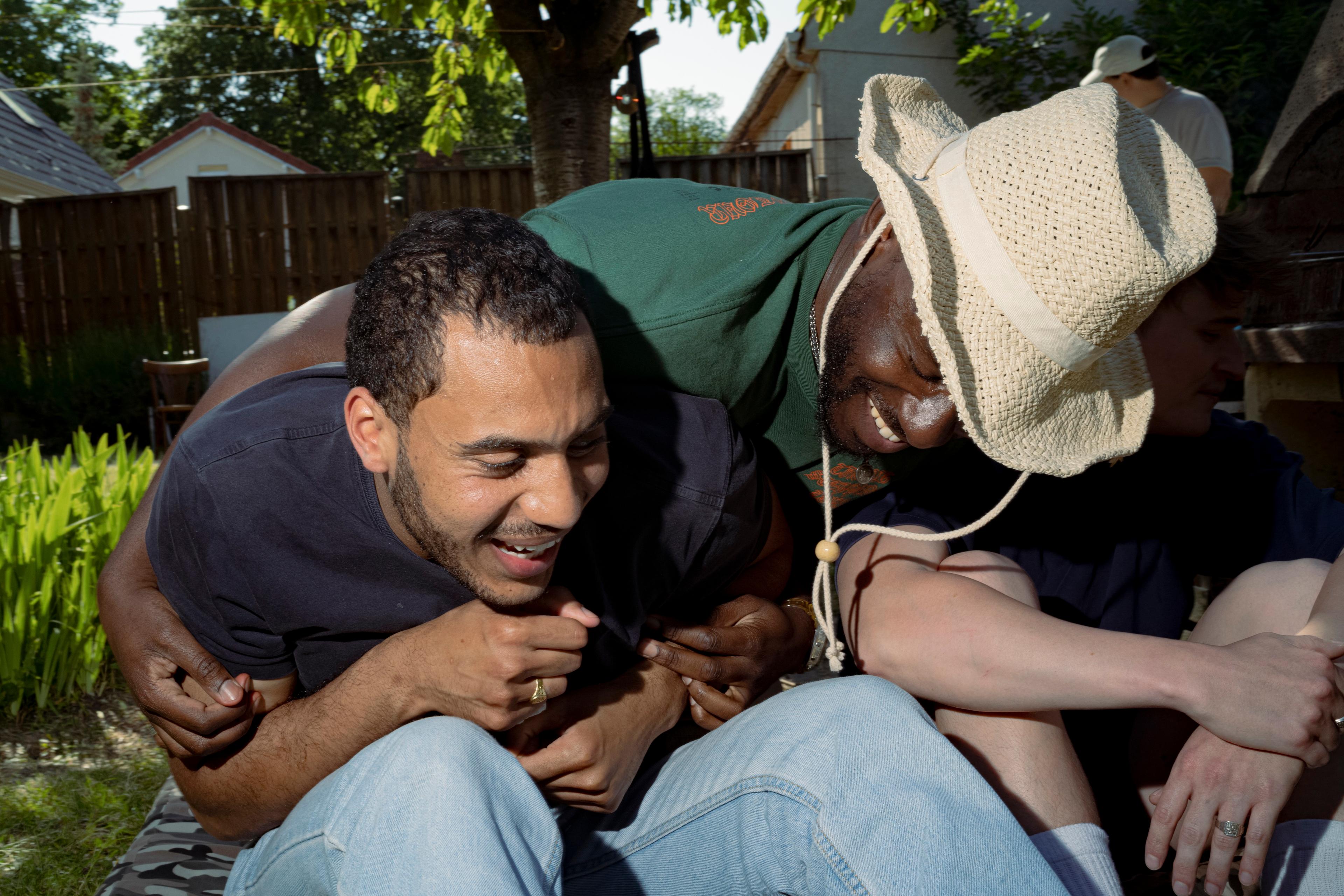When did you last feel a connection with someone? It was probably not too long ago. Laughing over a joke with a co-worker, sharing an emotional moment with a friend, or simply exchanging smiles with a child – instances of bonding like these occur daily. People are built to connect, from the tender moments in infancy when we seek comfort from caregivers to the various relationships that shape our personal and professional lives.
One of the most important factors in developing these connections is empathy: the ability to understand and resonate with another person’s experience. Empathy creates a bridge between people that helps them feel seen, heard and deeply connected. It also helps people manage their emotions in moments of distress. The mechanisms in the brain that allow this to happen, and the extent to which they can be observed and measured, have long captivated social neuroscientists, who seek to understand how brains support interaction.
Traditionally, research on the empathic brain has relied on methods like functional magnetic resonance imaging (fMRI), which examines brain activity in isolated individuals, one at a time, using large, stationary scanners. But since actual empathic interactions involve at least two people, social neuroscientists have sought ways to capture and analyse these dynamic exchanges. In our own neuroscience lab, we have been studying empathy as it unfolds in authentic, face-to-face encounters. To do this, we adopted a technique called hyperscanning, which allows us to record brain activity from multiple people simultaneously, making it possible to observe how their brains respond to one another in real time.
The hyperscanning studies conducted in our lab and in others have shown, remarkably, that during moments of social connection, when study participants are asked to cooperate, communicate and coordinate in some way, their neural activity begins to synchronise. It’s almost as if portions of their brains are operating as one: we observe patterns where fluctuations in neural activity in one person begin to align with those in the other. This phenomenon, known as interbrain synchronisation, can occur in corresponding brain regions (such as in both individuals’ frontal lobes), or a certain brain region in one person can synchronise with a different region in the other.
The phenomenon of two brains synchronising might help explain that felt sense of connection, the ‘click’ that two people experience in moments of deep presence with each other. Research shows that interbrain synchrony is strongly associated with behaviours that are prerequisites for successful social support, such as enhanced attention and coordination, successful prediction of another’s intentions, cooperation and effective communication. Examining a tactile form of social support, a hyperscanning study from 2018 showed that when one person held another person’s hand during a painful experience, the pair’s interbrain synchrony increased, creating a shared neural rhythm. Most strikingly, the stronger the interbrain synchrony was, the greater the pain relief for the person in distress, suggesting a neural basis for the power of social touch.
Of course, there are many ways in which one person can emotionally support another – besides a reassuring touch. People do this most often, perhaps, just by talking and listening to each other. We wanted to learn more about the role that interbrain synchrony plays in this fundamental empathic experience.
We recently developed a novel research paradigm called the ‘emotional sharing task’. Two previously unacquainted participants sit face to face and engage in the sharing of a personal, distressing experience. Imagine, for example, two individuals, Dan and Steve, meeting for the first time as they arrive at our lab. They sit across from each other, and each is fitted with a lightweight, non-invasive neuroimaging cap that uses a technology called functional near-infrared spectroscopy (fNIRS). They are intentionally matched on several characteristics, including age, sex, native language and right-handedness, as these factors can influence brain activity.
The observation-execution system allows people to nod in unison during a deep conversation or instinctively match each other’s tone
Dan, who recently went through a painful breakup after a six-year relationship, is invited to share the experience with Steve for five minutes. Steve’s role is to simply listen, connect, ask questions and be fully present. This setup allows us to study empathy and distress relief not as two separate processes, but as they unfold, live, between two human brains. Throughout the interaction, we measure each person’s brain activity to explore whether the degree of synchrony between them relates in some way to the empathy that Steve feels or the emotional relief that Dan feels.
In a recent study using this method, sharers and listeners like Dan and Steve engaged in conversation, and we examined the neural activity of two key regions in their frontal lobes. Each region is known to have a unique and complementary role in shaping empathic interactions. The first, the dorsolateral prefrontal cortex (dlPFC), is a core region for emotion regulation: it modulates distress, exerts cognitive control, and fine-tunes emotional responses to challenging situations. Whether you are suppressing anxiety or reframing negative thoughts, the dlPFC supports your ability to manage stress.
The second brain region we examined was the inferior frontal gyrus (IFG), which serves as a social synchroniser. The IFG is part of the larger ‘observation-execution system’, a brain system that enables the automatic activation of mental representations when one observes another person’s action, which leads to a mirrored response. The observation-execution system is what allows people to nod in unison during a deep conversation, instinctively match each other’s tone, or experience a shared rhythm in social interactions.
Looking at the brain activity patterns of people like Steve and Dan, we again discovered evidence of interbrain synchrony, in both the dlPFC and the IFG. Importantly, we also found that a higher degree of interbrain synchrony in these regions was predictive of greater relief for the person who shared what they had been through (judging by their self-reported levels of sadness). In other words, the more the two participants’ brain activity aligned, the more emotional relief seemed to result from the sharing. This highlights interbrain synchrony as a plausible mechanism behind the emotional connectedness and support people feel when they open up to each other.
Why might brain synchronisation be helpful for easing someone’s distress? Here’s how it could work. Picture Dan and Steve’s conversation: Dan starts talking about his romantic separation and the pain it has caused him. Steve watches and listens attentively, reflecting back some of Dan’s evident sadness in his own facial expression. Dan responds to this attention and interest, maintaining eye contact with Steve. On the surface, they unconsciously begin mirroring each other’s actions, whether by matching postures or facial signals, or aligning speech rhythms; beneath the surface, their brain activity also begins to synchronise as a result. This internal synchrony may facilitate further external mirroring and coordination, and increased feelings of connectedness.
The IFG region, again, allows for the mirroring of actions and intentions. As the IFGs of both individuals begin to activate in the same manner (ie, synchronise), Dan and Steve may increasingly begin mirroring each other, potentially leading to a shared experience of oneness, where there is a blur in the distinction between ‘self’ and ‘other’. This could help Dan feel less alone, making his emotions seem more manageable. Dan may also experience distress relief through the activation of reward-related processes in the brain; alignment, as seen in mimicry, can induce positive affect.
The alignment of activity in the dlPFC, the area that’s key for emotion regulation, might also contribute to reduced distress by supporting the collaborative regulation of emotions. As an empathic listener, Steve is tuning his responses to align with Dan’s emotional state. In doing so, he may attempt to manage Dan’s emotions, while Dan is simultaneously doing the same for himself, and for Steve. In essence, both are co-regulating each other’s emotions. As their dlPFCs become synchronised, Steve’s ability to offer attuned support, such as words of sympathy or advice, is likely to improve, leading to more effective and efficient emotion regulation.
With these possibilities in mind, you might want to pause for a moment the next time you feel that unmistakable ‘click’ when sharing an emotional experience with a receptive listener, or when a friend turns to you for support. You’re probably experiencing more than just ‘good chemistry’: you may be witnessing your brains synchronising in real time, a hidden biological rhythm that underlies empathy, connection and emotional understanding. What we’re learning about interbrain synchrony is a powerful reminder that the most meaningful interactions aren’t just happening on the outside, but are shared at a deep level – and that our brains are built not only to think, but to connect.








